Develop the future with “Hibikinada wind”
~ Genes of the environmental city“Kitakyushu”~
Feature PICK UP 若松を興す
As the demand for steel increased with the progres of modernization, the Meiji government hurried the construction of steel plants to increase self-sufficiency in steel, and in February 1901, the government-run Yahata Steel Works began operations. There were several candidate locations for the construction of the steelworks, but Yahata Village, Onga District, near the Chikuho Coalfield and facing Dokai Bay, was chosen because of its convenience in procuring coal for fuel and transporting steel. Behind this were the intentions of central capital such as Mitsui and Mitsubishi as well as local conglomerates that had expanded into the Chikuho coalfields such as Kaijima, Aso, and Yasukawa. After that, Wakamatsu became Japan’s number one coal shipping port, and the area around Dokai Bay became one of the country’s leading heavy and chemical industrial zones.
However, industrial pollution became increasingly serious from the 1960s, and it took 30 years to restore the contaminated environment. And now, based on the know-how accumulated as an environmental city, efforts toward a decarbonized society are beginning to take place in Hibikinada, Wakamatsu.
Citizen power that overcame industrial pollution
The era of “steel is the nation” turned into the era of “iron recession” and the citizens of Kitakyushu suffered from serious industrial pollution. During the 1960s, a period of high economic growth, Dokai Bay became increasingly polluted by wastewater from factories and residents, turning into a “Dead sea” where even E. coli could not be detected. In the Yahata area, “seven-colored smoke” containing iron oxide and carbon covered the sky, and soot and dust rained down.
Meanwhile, mothers concerned about their children’s health took action. Awareness of pollution has increased through citizen movements and the media, and companies and governments have also begun to strengthen anti-pollution measures. In 1970, the “Pollution Prevention Ordinance” was enacted. In the 1980s, the city was introduced both domestically and internationally as a region that had overcome industrial pollution, and urban environmental improvement began to be seen as important.
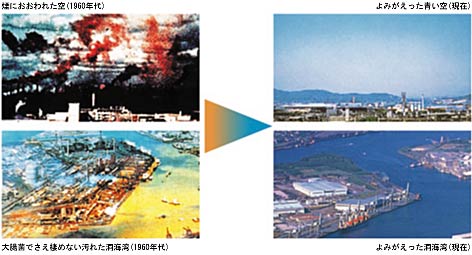
Companies took measures such as installing pollutant treatment facilities, greening factories, promoting resource and energy conservation, and introducing low-pollution production technology (clean production technology). Meanwhile, the government has put in place a scientific research system, including the establishment of a pollution monitoring center. Kitakyushu City has been selected as an “environmental city” because more than 100 types of seafood have returned to Dokai Bay, the air has become cleaner, and the environment has been improved through the combined efforts of citizens, government, and businesses. In 1988, the “Starry Sky City/Blue Sky City Summit” was held in Kitakyushu City, and a citizen movement aimed at improving the environment began to develop nationwide.
In 1991, the “Kitakyushu Eco Town Project” was launched to promote environmental conservation and industrial development, and in 2000, the “Kitakyushu City Basic Environmental Ordinance” was established. Kitakyushu City, which was selected as an “Environmental City of the Future” due to these efforts, has been strategically promoting “sustainable city development” since 2011.
International contribution of the environmental city “Kitakyushu”
In 1991, the East Asia (Yellow Sea Rim) Cities Conference was established based on the “Yellow Sea Rim Economic Zone Concept” proposed by Kitakyushu City. The members of the conference, which mainly consisted of city halls and commercial and industrial organizations, were from six sister cities, including Kitakyushu and Shimonoseki in Japan, Busan and Incheon in South Korea, and Dalian and Qingdao in China. In November 2004, it was expanded and reorganized as “THE ORGANIZATION FOR THE EAST ASIA ECONOMIC DEVELOPMENT” Member cities are Kitakyushu, Shimonoseki, Fukuoka, and Kumamoto in Japan. Incheon, Busan, and Ulsan in South Korea. These include Dalian, Qingdao, Yantai, and Tianjin in China. As for the organizational structure, in addition to the organizational meeting attended by the mayor and the president of the chamber of commerce, four subcommittees were established, including international business, environment, logistics, and tourism.
In particular, the activities of the Environment Committee were eye-opening. Joint projects aimed at promoting low-carbonization were carried out, including the sharing of environmental information between member cities, the exchange of environment-related businesses, the development of environmental human resources, technology exchange seminars, business meetings, coastal cleaning projects, and light down campaigns. From the perspective of the author, who was involved in the management of the Environmental Subcommittee at the time, the efforts of member cities in South Korea and China were serious. How can we overcome industrial pollution, which is becoming more serious due to rapid economic growth? Cities in China and South Korea aiming for environmental regeneration were eagerly absorbing Kitakyushu’s policies and experience.
Ulsan is the home of Hyundai Motor Company, boasts the largest volume of automobile production in Korea, and is an industrial city of 1.1 million people with a concentration of shipbuilding, heavy industry, and oil complexes. As a result, Ulsan suffered from serious industrial pollution, and in the 1990s, the Taehwa River that ran through the city center was called the “Dead river” with a foul smell from large amounts of industrial waste and domestic wastewater.
In order to improve water quality, which was said to be the worst in Korea, Ulsan City introduced the “Kitakyushu Method” in its organizations and measures related to environmental administration, and many related parties from Kitakyushu City visited Ulsan City. Through efforts based on the success story of Kitakyushu City, the Taiwa River was decontaminated in 2016 and the water quality of the first-class river was restored. Currently, the Taehwa River cleanup case is introduced in elementary and junior high school social studies textbooks, and a large-scale bamboo forest park has been created along the river, which has become a landmark of Ulsan City. In addition, recently, with the aim of forming a next-generation energy base, the city has been used as a demonstration city for hydrogen electric vehicles, and infrastructure development for a decarbonized society is progressing.
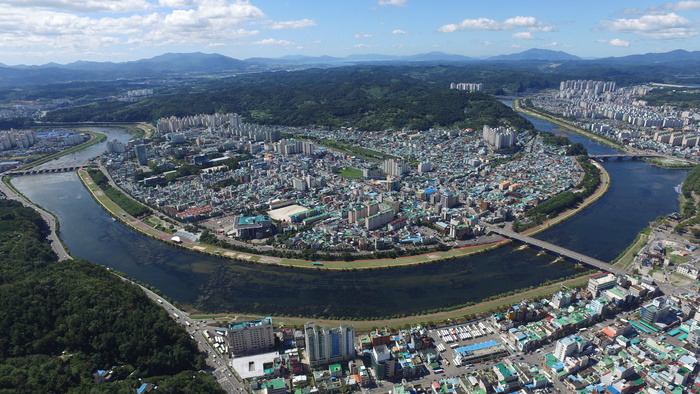
Decarbonization policy as seen in the “Green Growth Strategy”
According to materials from the Kitakyushu City Environment Bureau, greenhouse gas emissions in the city are decreasing year by year, and the total emissions in 2020 were 13.13 million tons (CO₂ equivalent), a 29.4% decrease compared to 2013. . Kitakyushu City has a large amount of emissions from the industrial sector, and there are many material manufacturing companies, so there are many challenges to reducing CO2 emissions. In order to respond to this situation, Kitakyushu City formulated a “Green Growth Strategy” in January 2022. In order to realize a carbon-free city in 2050, we have set a goal of reducing greenhouse gas emissions by more than 47% by 2030 (compared to 2013).
Specifically, we will expand the introduction of renewable energies such as solar, wind, biomass, garbage incineration, and hydropower, aiming for local production and local consumption of renewable electricity, as well as building reuse systems such as solar panels and storage batteries, and The aim is to cluster related industries at the wind power generation base port. Through these measures, 2,730 to 2,980 GWh/year of renewable electricity will be generated in 2030, covering about 30% of the city’s current electricity demand. Approximately 36% of that amount is expected to be supplied by offshore wind power.
Economic ripple effects of offshore wind power generation
The offshore wind power plant construction plan underway in Wakamatsu Ward is one of the pillars of Kitakyushu’s green growth strategy. The project implementation area is approximately 2,700 hectares (1-10 km north-south, 11 km east-west) off the coast of Hibikinada, and a total of 25 large wind turbines with an output of 9,600 kW will be installed in four areas. The maximum output is a total of 220,000 kW, and the annual power generation amount is approximately 500 million kW, which is equivalent to the electricity needed for approximately 170,000 ordinary households.
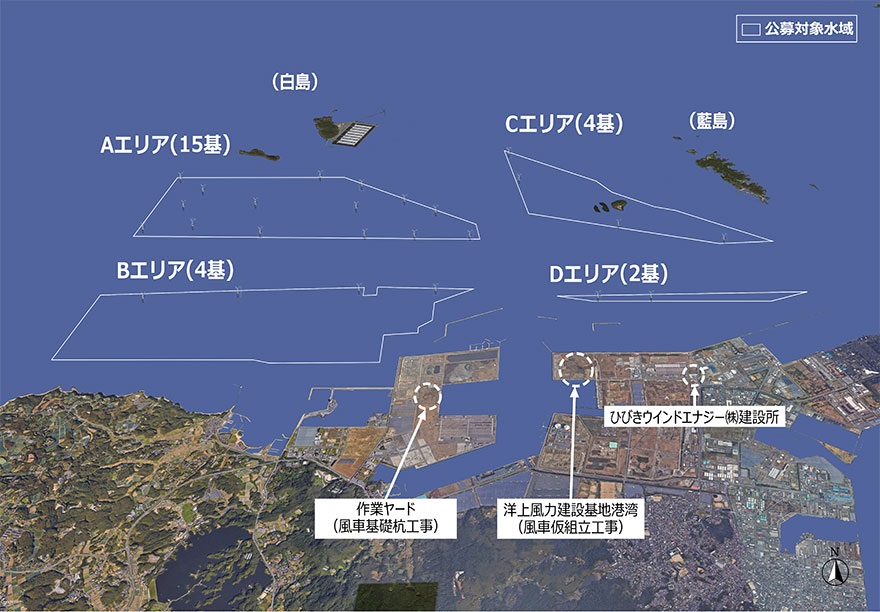
< Source: Hibiki Wind Energy >
The total construction cost for the Hibikinada Wind Farm Project, which began construction in March last year, is approximately 170 billion yen. The project, which aims to begin operations in fiscal 2025, will be led by Hibiki Wind Energy Co., Ltd., an investment group made by five companies, including local companies. Mayor Takeuchi, who spoke at the groundbreaking ceremony, said, “I want to use the start of offshore wind power generation construction as a catalyst to create a cycle in which companies will gather and jobs will be created.”
This project, which is a successor to the “Green Energy Port Hibiki Project” that has been underway since 2011, has great significance not only in terms of diversifying electricity supply but also in terms of industrial promotion. It is no exaggeration to say that the concentration of industry in the Hibikinada area, which has vast industrial land and extensive port facilities, is a trump card for revitalizing the Kitakyushu economy.
In particular, the offshore wind power generation business is expected to attract a number of related companies, as it involves various industries such as component manufacturing, assembly work, wind turbine operation management, submarine cable and wind turbine maintenance management, and land and sea logistics. In terms of job creation, the demand for technicians, engineers, maintenance staff, etc. will increase, and the increase in the number of employees associated with the construction of wind power plants will lead to the revitalization of the local economy. Furthermore, the development of a power transmission network through offshore power generation will improve the efficiency of local infrastructure, which, combined with a stable supply of electricity, will be a major selling point for Kitakyushu City, which is promoting activities to attract companies.
In addition, from the perspective of promoting tourism, the sight of 25 large windmills with rotating blades (rotors) 174 meters in diameter lined up 200 meters above sea level off the coast of Hibikinada is a spectacular sight, it has become a tourist spot. In the future it is expected to improve the convenience of the surrounding area as a key point on the Wakamatsu sightseeing route that connects Wakato Ohashi Bridge to Eco Town, Wakamatsu North Coast, and the research city.
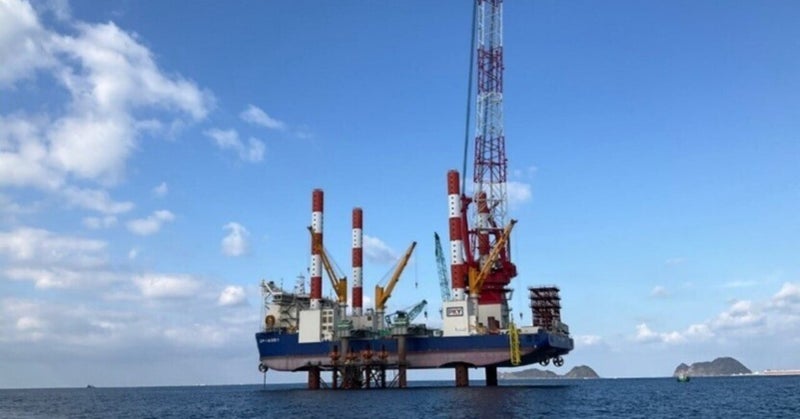
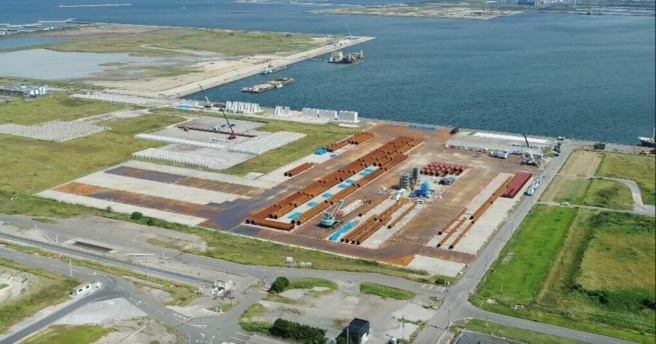
Amid the global trend of decarbonization, Kitakyushu City, which has set its sights on becoming a zero-carbon city by 2050, is aiming to create a new city where the environment and economy are in a virtuous cycle. Decarbonization strategies for local companies and the creation of new industries, which industry, academia, and government are working on together, will also stimulate young people’s desire to work locally. In this sense, it is important to achieve the goals of achieving a decarbonized society by 2030, and a key point will be how to realize the potential of the Wakamatsu region, which will be the base for this.
Please see the website below for information on “Green Growth Strategy” and “Hibiki Wind Energy”
●Kitakyushu Green Growth Strategy
https://www.city.kitakyushu.lg.jp/files/000967655.pdf
●Hibiki Wind Energy Co., Ltd.
https://hibikiwindenergy.co.jp/








